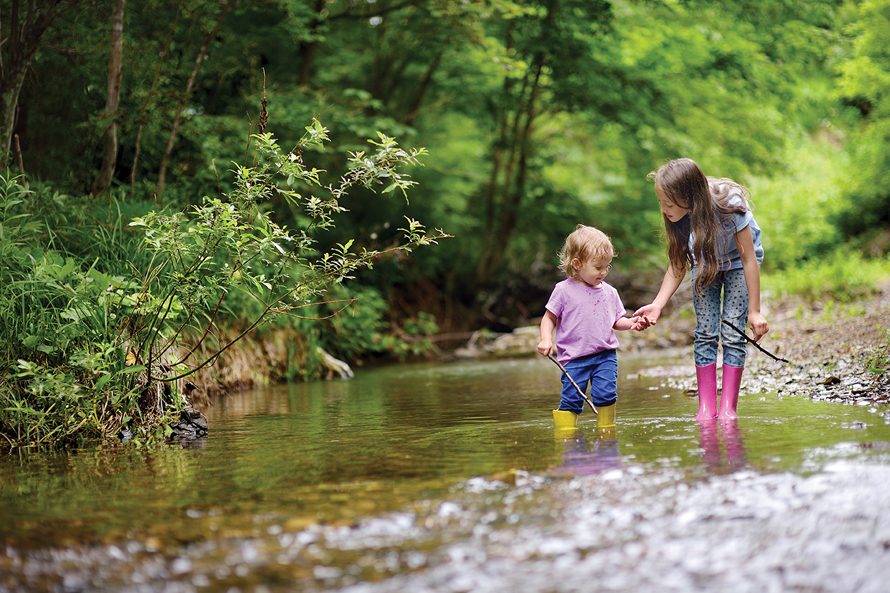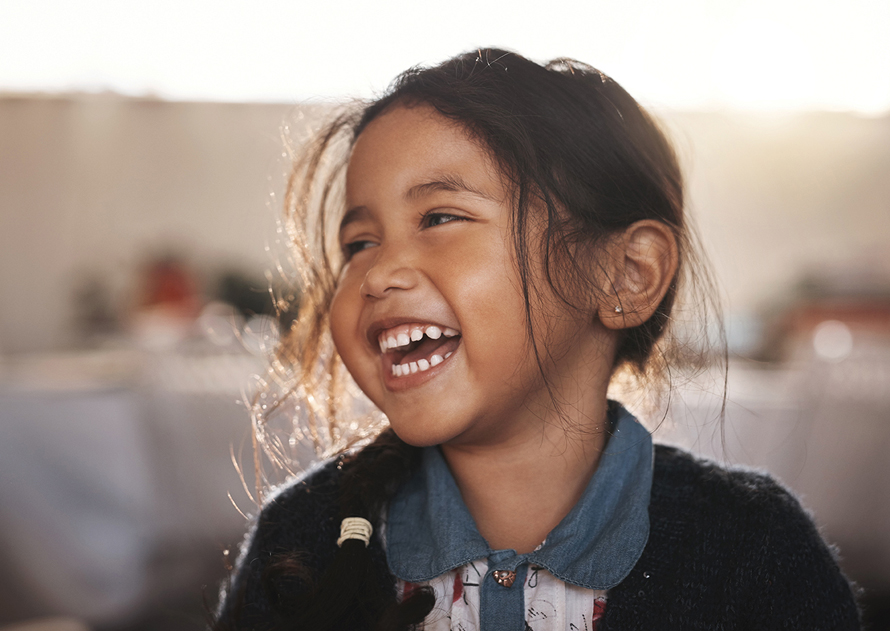
Imagine this scenario: A neighbor kid is at your door, asking your 8-year-old if he can come outside and play. As your child scrambles to put on his shoes, you remind him he has homework to do. He wavers, then shoots you a zinger:
“Sorry, Mom. Remember? Doctor’s orders — I gotta play.”
Your pediatrician probably hasn’t yet written your child a prescription for hiking or hoops, but some experts hope that a standard well-child visit, especially for younger kids, will eventually include a checkup on how — and how much — your child plays.
Why? More and more evidence suggests what many observant parents, educators and kids themselves know intuitively: that ordinary child’s play is essential to learning and development.
|
For more support and resources surrounding the youth mental health crisis, screen time and social media, and the importance of play, visit ParentMap’s Antidote for the Anxious Generation page. |
A few years ago, the American Academy of Pediatrics (AAP) made waves by publishing a paper titled “The Power of Play” in the influential journal Pediatrics. It stated that developmentally appropriate play is so vital to the health and well-being of children that pediatricians should advocate unstructured play and playful learning for kids in different settings — and even write “prescriptions for play.”
“At a time when early childhood programs are pressured to add more didactic components and less playful learning, pediatricians can play an important part in emphasizing the role of a balanced curriculum that includes the importance of playful learning for the promotion of healthy child development,” states the report.
Which begs the question: Is play — something that children and all mammals do naturally from infancy — really in such short supply that we need a medical intervention?
And what is play, anyway — why is it so important?
“The Power of Play” report loosely defines play as “an activity that is intrinsically motivated, entails active engagement, and results in joyful discovery.”
Kids define it even more simply. When I asked a few children, here are some of the phrases they used: “Free time, doing what you want to do.” “When you go to the living room and get out all your toys and do what you want.” “Fun things that make you laugh.” “Going to the park.”
Play is a safe space where you get to try out stuff you can’t try anywhere else.
Kathy Hirsh-Pasek, Ph.D., a fellow in Temple University’s Department of Psychology and author of 14 books about child development, co-wrote “The Power of Play.” She subscribes to a similarly grounded definition.
“Play is a safe space where you get to try out stuff you can’t try anywhere else,” she says. “It’s the ultimate soup. It’s got all the right ingredients. It even disguises the veggies.”
If you start dipping into the abundant research on how various forms of play benefit kids, you might never come up for air. The AAP report sums it up well: “Play is fundamentally important for learning 21st-century skills, such as problem solving, collaboration and creativity, which require the executive functioning skills that are critical for adult success.”
Simply put, play is how kids learn, says Amelia Bachleda, Ph.D., outreach and education director for the University of Washington’s Institute for Learning & Brain Sciences (I-LABS). “[Through play], children are able to explore their world in a context that’s individualized exactly for what they’re interested in in the moment and what they want to explore.”
Perhaps most critically, the paper summarizes research indicating that play is an important buffer against toxic stress, which — as you’ve probably noticed — is reaching epic proportions in kids and teens. Studies show that playing with teachers and peers can alleviate stress and anxiety in young children. More research is also emerging on the role of outdoor play in reducing stress, anger and aggression in kids.
Play, as you’ve probably also heard, is on the decline. According to one study, from 1981 to 1997, children’s playtime decreased by 25 percent. Thirty percent of kindergartners no longer have recess. As has been exhaustively detailed by journalist Richard Louv (author of “Last Child in the Woods: Saving Our Children From Nature-Deficit Disorder”) and others, outdoor and nature play is especially endangered.
Can all this attention to play reverse this seriously unamusing trend? Hirsh-Pasek says she and other authors of “The Power of Play” were thrilled by the coverage the report received, with stories featured in every major newspaper and morning show.
The authors don’t currently have a way to track how pediatricians apply the recommendations, but Hirsh-Pasek says the response has been encouraging.
“Pediatricians are now aware, and that’s a big deal. And there are people doing stuff about it, coming up with new programs around play, helping parents who don’t know how to play learn to play. It’s almost as if we’ve forgotten these very basic instincts, and we need to bring them back.”

What are you waiting for? Go outside and play!
When you talk about the decline of play in children, the conversation quickly goes outside.
Nature and outdoor play have enormous benefits for kids, including good physical health, improved vision, better gross motor skills, emotional regulation, even empathy. But as noted above, kids are indoors more than ever.
Factors abound: the rise of digital media, an upsurge in structured activities and increased parental fears, to name a few. Many kids lack access to safe outdoor play spaces. If they do have access, perceived dangers or fear of parents’ judgment keep kids inside.
Ask a pediatrician about this trend and they’ll no doubt have a story to share. Danette Glassy, M.D., a Mercer Island pediatrician, will tell you about the time she asked a 6-year-old patient what she liked to do outside. The response? “Oh, Dr. Glassy, I’m not an outdoor girl.”
“I wanted to cry!” recounts Glassy. “We had to talk a long time about why she wasn’t an outdoor girl. Could she go outside at her house and tell me when she comes back next year what that was like for her?”
Glassy and several other pediatricians associated with the nonprofit BestStart Washington started thinking about what they could do to plant a seed at the beginning of children’s lives that might blossom into a family and personal habit of outdoor play.
In 2018, this concept bloomed into BestStart Washington’s Project Nature, an initiative that aims to increase kids’ access to nature through a multipronged effort: First, at well-child visits for ages 1–3, pediatricians talk to families about the benefits of nature play and give each child a small bag with an age-appropriate outdoor toy (e.g., a spade and seeds, a bug box, a pocket kite). The kit also includes a colorful brochure detailing the benefits of outdoor play and easy ideas for how to do it: belly hikes for 1-year-olds, mud play for 2-year-olds and so on. Parents are also directed to the project website, a clearinghouse of places, activities and resources.
The project is a cousin of the ParkRx movement, a rapidly growing national effort that encourages physicians to prescribe time in nature “with the goal of improving [patients’] health and well-being.” Recently profiled in Outside magazine, ParkRx reports that as of a year ago, the United States had at least 71 provider-based nature prescription programs in 32 states.
But the people involved in Project Nature make an important distinction between their project and the parks prescription movement: They’re not “prescribing.”
Glassy says the goal is more about “joining” with families, rather than “telling them what to do.” Much like Reach Out & Read, a very successful 30-year-old program that promotes literacy and hands out books at well-child visits, Project Nature includes a fun physical component.
Project Nature, which piloted its play kit with 60 families in three different pediatric clinics, is gathering survey data and other feedback on the model before reshaping and rolling it out more broadly this year. (Among the changes it will make: addressing weather and providing materials in Spanish.) It says it’s focused on reaching families with the most need and hopes to eventually partner with child-care centers as well as share its resources more broadly.
Seattle Children’s researcher and pediatrician Pooja Tandon, M.D., who is known for her research on kids and physical activity and is an adviser for Project Nature, believes that the model is a natural outgrowth of wellness questions that pediatricians already ask.
“Children need physical activity and to play outdoors. Even well-meaning parents might not be able to make that happen. Pediatricians and health-care providers have a role in asking about things, indicating that it is a priority,” she says.
Whitney Hemker and her then-2-year-old daughter, Penelope, participated in the Project Nature pilot program through Glassy’s practice, which included filling out a questionnaire about the family’s outdoor play habits.
Though Hemker, a fifth-grade teacher, was already knowledgeable about the benefits of outdoor play, the process of quantifying how much time the family actually spent outside was helpful.
“I appreciated the reinforcement of ‘Yes, we need to get outside, even when it’s cold.’ We’re more intentional about dedicating time when there’s awareness of the need,” Hemker says.
Penelope, for her part, was delighted with the bug box she received as part of her play kit. “She points out every bug we see now,” says her mom.
This Is Your Kid’s Brain on Play: 6 Fun Facts
1. Play increases social skills. Studies using rats show that play appears to spark changes in areas of the brain used for thinking and pro-social behavior.
2. Pretend play increases cognitive function. In one study, children who are better at pretending proved better at thinking about and imagining different possibilities.
3. Play builds resilience. According to the “The Power of Play” report, play “may indirectly affect brain functioning by modulating or buffering adversity and by reducing toxic stress to levels that are more compatible with coping and resilience.”
4. Playing syncs cooperation. Swinging in synchronicity seems to increase kids’ ability to cooperate with each other, a study by the University of Washington’s Institute for Learning & Brain Sciences found.
5. Play helps kids learn. In a study conducted in Texas schools, kids who got more recess time were more disciplined and focused in class, and they performed better academically than peers who did not get extra recess.
6. Outdoor play helps with everything. Numerous studies correlate outdoor play and time in nature with “physical activity, improved motor skills, and better vision and vitamin D levels,” as Dr. Pooja Tandon and co-author Kyle Yasuda, M.D., wrote in an op-ed for The Seattle Times. Look for more health research emerging from the University of Washington’s Nature for Health Initiative at EarthLab.
Play access and equity
Pediatricians have unparalleled access to families, yet can a few minutes at a well-child visit make a difference in troubling trends such as the childhood obesity epidemic and the decline in physical activity and playtime for kids?
Access to outdoor play, in particular, reflects larger societal inequities. Children in lower-income neighborhoods have less access to safe parks and greenspaces.
“For parents who work two or three jobs, it can be hard to get kids outside,” says Beth Harvey, M.D., one of the pediatricians who piloted Project Nature; 50 percent of the patients in her Olympia practice are on Medicaid. “Safety is a big issue. Lots of our patients live in apartment complexes without a play area. They don’t have transportation or the ability to get to a park. That’s a challenge.”
There are also cultural considerations, says Khavin Debbs, deputy executive director for the Tiny Trees outdoor preschool.
Debbs spent a lot of time outdoors as a child, but his father wasn’t part of his experience. “My dad worked for the railroads for 40 years. He would spend his days outside. When he came home, the last thing he would want to do is take me to a park.”
In addition, stereotypical images of outdoor recreation might not feel welcoming to children of color. “It’s a white dude with a five o’clock shadow jumping off a rock,” says Debbs. “When I see that as a Black person or even as a kid, that’s telling me straight up that this isn’t a place where I belong.”
Through his work with Tiny Trees, Debbs hopes to help kids weave an updated story of playing in nature. “We’re getting them outside, building those positive experiences with the outdoors. They’ll be able to change that narrative about being in the outside.”
Project Nature is learning from initiatives in other cities. Founded by pediatrician and clinical scientist Nooshin Razani, M.D., Children’s Hospital Oakland’s Center for Nature and Health in California not only prescribes time in nature for its patients — 90 percent of whom live in poverty — but leads families on monthly nature outings. In a Sierra magazine article, Razani notes that a randomized study indicated that “every single park visit substantially reduced parent stress.” Closer to home, University of Washington’s EarthLab is launching research into the benefits of time in nature for kids (among other groups).
Schools can play an important role, says Tandon, by helping schoolyards double as nature spaces for families with little access to parks. She points to the green schoolyards movement, which aims to leverage the 2 million acres managed by U.S. public schools as community greenspaces. “Many cities don’t have space to put in a park … but every community has a school,” she says.
Between homes, schools and parks are sidewalks, streets and bus stops. Hirsh-Pasek tells of another project, Learning Landscapes, that essentially “prescribes” play for cities.
Working with city designers, community organizations and nonprofits such as Kaboom!, Learning Landscapes advocates turning ordinary urban elements — such as bus stops and park benches — into playful experiences that encourage learning. The City of Seattle is presently working with Learning Landscapes to mark safe routes to schools with playful designs.
“The vision is to have all cities make this part of how you do business,” explains Hirsh-Pasek.
Lightening up on play
So, what are the takeaways for parents? Should we add making sure our kids get enough play — unstructured play, outdoor play, play with us — to the top of our already teetering to-do list? Is this another thing we should feel guilty about?
According to all the experts I interviewed, the answer to that question is a resounding no.
What I heard instead was this: Yes, be aware of how important play is and advocate where you can. But also: Relax, pay attention. Allow small moments of play to unfold, wherever you are.
Tiny Trees’ Khavin Debbs says, “The way that kids are going to learn from those moments is to allow those moments to happen. Something as simple as picking up a rock, seeing a snail, climbing a tree.”
Tandon, the mother of two boys, reminds us that outings don’t have to be a big deal, a lesson she learned when her sons were small and “we would drive two hours to get to a beautiful setting, and they would play with the same rocks and sticks [they would play with home].”
I’ve noticed that my 9-year-old son frequently writes his own tiny “play prescriptions,” taking time between structured activities or homework to connect with Lego mini figures or a basketball.
Hirsh-Pasek gives her own example of walking with her young granddaughter in the woods and looking at shadows. “She was amazed.” Soon she was asking about what this “shadow thing” was: “When does it come out? When doesn’t it?” They started observing, then predicting. Soon, “we had a hypothesis.”
“Every single day, every moment, is an opportunity,” says Hirsh-Pasek, “to change the lens on an everyday routine.”

Playful ResourcesWant to become a play advocate? Start here.
|











